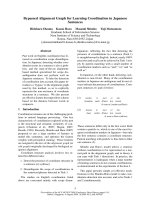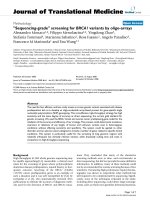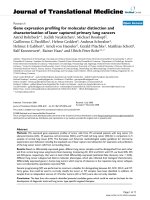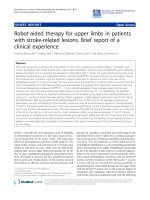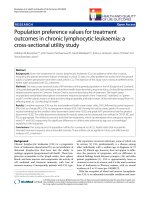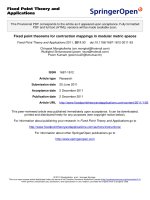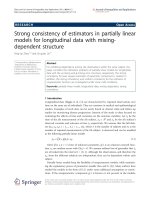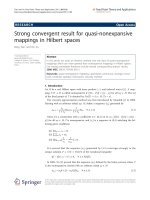Báo cáo hóa học: " Strong convergent result for quasi-nonexpansive mappings in Hilbert spaces" doc
Bạn đang xem bản rút gọn của tài liệu. Xem và tải ngay bản đầy đủ của tài liệu tại đây (277.29 KB, 8 trang )
RESEARC H Open Access
Strong convergent result for quasi-nonexpansive
mappings in Hilbert spaces
Ming Tian
*
and Xin Jin
* Correspondence:
College of Science, Civil Aviation
University of China, Tianjin 300300,
China
Abstract
In this article, we study an iterative method over the class of quasi-nonexpansive
mappings which are more gene ral than nonexpansive mappings in Hilbert spaces.
Our strong convergent theorems include several corresponding authors’ results.
2000 MSC: 58E35; 47H09; 65J15.
Keywords: quasi-nonexpansive mapping, Lipschitzian continuous, strongly mono-
tone, nonlinear operator, fixed point, viscosity method
1. Introduction
Let H be a real Hilbert space with inner product 〈·,·〉, and induced norm ||·||. A map-
ping T: H ® H is called nonexpansive if ||Tx - Ty|| ≤ ||x-y|| for all x,y Î H. The set
of the fixed points of T is denoted by Fix(T):={x Î H: Tx = x}.
The viscosity approximation method was first introduced by Moudafi [1] in 2000.
Starting with an arbitrary initial x
0
Î H, define a sequence {x
n
} generated by
x
n+1
=
ε
n
1+ε
n
f (x
n
)+
1
1+ε
n
Tx
n
, ∀ n ≥ 0
,
(1:1)
where f is a contraction with a coefficient a Î [0,1) on H, i.e., ||f(x)-f(y)|| ≤ a||x-
y|| for all x,y Î H, T is nonexpansive, and {ε
n
} is a sequence in (0,1) satisfying the fol-
lowing given conditions:
(i1) lim
n®∞
ε
n
=0;
(i2)
∞
n
=
0
ε
n
=
∞
;
(i3)
lim
n→∞
(
1
ε
n
−
1
ε
n
+1
)=
0
.
It is proved that the sequence {x
n
} generated by (1.1) converges strongly to the
unique solution x* Î C(C := Fix(T)) of the variational inequality:
(
I − f
)
x
∗
, x − x
∗
≥0, ∀ x ∈ Fix
(
T
).
In 2003, Xu [2] proved that the sequence {x
n
} defined by the below process where T
is also nonexpansive, started with an arbitrary initial x
0
Î H:
x
n+1
= α
n
b +
(
I − α
n
A
)
Tx
n
, ∀ n ≥ 0
,
(1:2)
Tian and Jin Fixed Point Theory and Applications 2011, 2011:88
/>© 2011 Tia n and Jin; l icensee Springer. This is an Open Access article distributed under the terms of the Creative Commons Attribution
License ( which permits unrestricted use, distribution, and reproduction in any medium,
provided the original work is properly cited.
converges strongly to the unique solution of the minimization problem (1.3) when
the sequence {a
n
} satisfies certain conditions:
min
x∈C
1
2
Ax, x−x, b
,
(1:3)
where C is the set of fixed points set of T on H and b is a given point in H.
In 2006, Marino and Xu [3] combined the iterative method (1.2) with the viscosity
approximation method (1.1) and considered the following general iterative method:
x
n+1
= α
n
γ f
(
x
n
)
+
(
I − α
n
A
)
Tx
n
, ∀ n ≥ 0
.
(1:4)
It is proved that if the sequence {a
n
} satisfies appropriate conditions, the sequence
{ x
n
} generated by (1.4) converges strongly to the unique solution of the variational
inequality:
(
γ f − A
)
˜
x, x −
˜
x≤0, ∀ x ∈ C
,
(1:5)
or equivalently
˜
x = P
Fix
(
T
)
(I − A + γ f )
˜
x
, where C is the fixed point set of a nonexpan-
sive mapping T.
In 2009, Maingè [4] considered the viscosity approximation method (1.1), and
expanded the strong convergence to quasi-nonexpansive mappings in Hilbert space.
In 2010, Tian [5] considered the following general iter ative method under the frame
of nonexpansive mappings:
x
n+1
= α
n
γ f
(
x
n
)
+
(
I − μα
n
F
)
Tx
n
, ∀ n ≥ 0
,
(1:6)
and gave some strong convergent theorems.
Very recently, Tian [6] extended (1.6) to a more general scheme, that is: the mapping
f: H ® H is no longer a contraction but a L-Lipschitzian continuous operator with
coefficient L > 0, and proved that if the sequence {a
n
} satisfies appropriate conditions,
the sequence {x
n
} generated by x
n+1
= a
n
gf(x
n
)+(I - μa
n
F)Tx
n
converges strongly to
the unique solution
˜
x ∈ Fix
(
T
)
of the variational inequality where T is still nonexpan-
sive:
(
γ f − μF
)
˜
x, x −
˜
x≤0, ∀ x ∈ Fix
(
T
).
(1:7)
Motivated by Maingè [4] and Tian [6], we consider the following iterative process:
x
0
= x ∈ H arbitrarily chosen,
x
n+1
= α
n
γ f (x
n
)+(I − α
n
μF)T
ω
x
n
, ∀ n ≥ 0
,
(1:8)
where f is L-Lipschitzian, T
ω
=(1-ω)I + ωT,andT is a quasi-nonexpansive map-
ping. Under some appropriate conditions on ω and {a
n
}, we obtain strong convergence
over the class of quasi-nonexpansive mappings in Hilbert spaces. Our result is more
general than Maingè’s [4] conclusion.
2. Preliminaries
Throughout this article, we write x
n
⇀ x to indicate that the sequence {x
n
}converges
weakly to x. x
n
® x implies that the sequence {x
n
} converges strongly to x. The follow-
ing lemmas are useful for our article.
The following statements are valid in a Hilbert space H: for each x,y Î H, t Î [0,1]
Tian and Jin Fixed Point Theory and Applications 2011, 2011:88
/>Page 2 of 8
(i) ||x + y|| ≤ ||x||
2
+2〈y, x + y〉;
(ii) ||(1 - t)x + ty||
2
=(1-t)||x||
2
+ t||y||
2
-(1-t)t||x - y||
2
;
(iii)
x, y = −
1
2
x − y
2
+
1
2
x
2
+
1
2
y
2
.
Lemma 2.1. Let f: H ®H be a L-Lipschitzian continuous operator with coefficient L >
0. F: H ® Hisa-Lipschitzian continuous and h-strongly monotone operator with >
0 and h >0.Then, for 0<g ≤ μh/L,
x − y,
(
μF − γ f
)
x −
(
μF − γ f
)
y≥
(
μη − γ L
)
x − y
2
.
(2:1)
That is, μF - gf is strongly monotone with coefficient
μη −
γ L
.
Lemma 2.2. [4]Let T
ω
:= (1 - ω)I + ωT, with T quasi-nonexpansive on H, Fix(T) ≠
∅, and ω Î (0,1]. Then, the following statements are reached:
(a1) Fix(T )=Fix(T
ω
);
(a2) T
ω
is quasi-nonexpansive;
(a3) ||T
ω
x - q||
2
≤ ||x - q||
2
- ω(1 - ω)||Tx - x||
2
for all x Î H and q Î Fix(T);
(a4)
x − T
ω
x, x − q≥
ω
2
x − Tx
2
for all x Î H and q Î Fix(T).
Proposition 2.3. From the equality (iii) and the fact that T is quasi-nonexpansive, we
have
x − Tx, x − q = −
1
2
Tx − q
2
+
1
2
x − Tx
2
+
1
2
x − q
2
≥
1
2
x − Tx
2
.
(a4) is easily deduced by I-T
ω
= ω(I-T) and the previous inequality.
Lemma 2.4. [7]Let {Γ
n
} be a sequence of real numbers that does not decrease at infi-
nity, in the sense t hat there exist a subsequence
{
n
j
}
j≥
0
of {Γ
n
} which satisfies
n
j
<
n
j
+
1
for all j ≥ 0. Also, consider the sequence of integers
{τ (n)}
n≥n
0
defined by
τ
(
n
)
=max{k ≤ n |
k
<
k+1
}.
Then,
{τ (n)}
n≥n
0
is a nondecreasing sequence verifying lim
n®∞
τ(n)=∞ and for all n ≥
n
0
, it holds that Γ
τ(n)
< Γ
τ(n)+1
and we have
n
≤
τ
(
n
)
+1
.
Recall the metric projection P
K
from a Hilbert space H to a closed convex subset K
of H is defined: for each x Î H the unique element P
K
x Î K such that
x − P
K
x := inf{x −
y
:
y
∈ K}
.
Lemma 2.5. Let K be a closed convex subset of H. Given x Î H, and z Î K, z = P
K
x,
if and only if there holds the inequality:
x − z,
y
− z
≤ 0, ∀
y
∈ K
.
Lemma 2.6. If x* is the solution of the variational inequality (1.7) with T: H ® H
demi-closed and {y
n
} Î H is a bounded sequence such that ||Ty
n
- y
n
|| ® 0, then
lim inf
n
→∞
(μF − γ f )x
∗
, y
n
− x
∗
≥0
.
(2:2)
Tian and Jin Fixed Point Theory and Applications 2011, 2011:88
/>Page 3 of 8
Proof. We assume that there exists a subsequence
{y
n
j
}
of {y
n
} such that
y
n
j
˜
y
.
From the given conditions
T
y
n
−
y
n
→
0
and T: H ® H demi-closed, we have that
any weak cluster point of {y
n
} belongs to the fixed point set Fix(T). Hence, we con-
clude that
˜
y ∈ Fix
(
T
)
, and also have that
lim inf
n→∞
(μF − γ f)x
∗
, y
n
− x
∗
= lim
j
→∞
(μF − γ f )x
∗
, y
n
j
− x
∗
.
Recalling (1.7), we immediately obtain
lim inf
n
→∞
(μF − γ f )x
∗
, y
n
− x
∗
= (μF − γ f )x
∗
,
˜
y − x
∗
≥0
.
This completes the proof. □
3. Main results
Let H be a real Hilbert space, let F be a -Lipschitzian and h-strongly monotone
operator on H with k >0,h >0,andletT beaquasi-nonexpansivemappingonH,
and f is a L-Lipschitzian mapping with coefficient L > 0 for all x,y Î H. Assume the set
Fix(T) of fixed points of T is nonempty and we note that Fix(T) is closed and convex.
Theorem 3.1. Let
0 <μ<2η/κ
2
,0 <γ <μ(η −
μκ
2
2
)/L = τ /
L
, and start with an
arbitrary chosen x
0
Î H, let the sequence {x
n
} be generated by
x
n+1
= α
n
γ f
(
x
n
)
+
(
I − α
n
μF
)
T
ω
x
n
,
(3:1)
where the sequence {a
n
} ⊂ (0,1) satisfies lim
n® ∞
a
n
=0,and
∞
n
=
0
α
n
=
∞
. Also
ω ∈ (0,
1
2
)
, T
ω
:= (1 - ω)I + ωI with two conditions on T:
(C1) ||Tx - q|| ≤ ||x - q|| for any x Î H, and q Î Fix(T); this means that T is a
quasi-nonexpansive mapping;
(C2) T is demi-closed on H; that is: if {y
k
} Î H, y
k
⇀ z, and (I-T)y
k
® 0, then z Î
Fix(T).
Then,{x
n
} converges strongly t o the x* Î Fix(T ) wh ich is the unique solution of t he
VIP:
(
μF − γ f
)
x
∗
, x − x
∗
≥0, ∀ x ∈ Fix
(
T
).
(3:2)
Proof. First, we show that {x
n
} is bounded.
Take any p Î Fix(T), by Lemma 2.2 (a3), we have
x
n+1
− p
= α
n
γ f (x
n
)+(I − α
n
μF)T
ω
x
n
− p
= α
n
γ (f (x
n
) − f (p)) + α
n
(γ f (p) − μFp)+(I − α
n
μF)T
ω
x
n
− (I − α
n
μF)p
≤ α
n
γ Lx
n
− p + α
n
γ f (p) − μFp +(1− α
n
τ )x
n
− p
≤
(
1 − α
n
(
τ − γ L
))
x
n
− p + α
n
γ f
(
p
)
− μFp.
(3:3)
By induction, we have
x
n
− p≤max
x
0
− p,
γ f (p) − μFp
τ − γ L
, ∀ n ≥ 0
.
Tian and Jin Fixed Point Theory and Applications 2011, 2011:88
/>Page 4 of 8
Hence, {x
n
} is bounded, so are the {f(x
n
)} and {F(x
n
)}.
From (3.1), we have
x
n+1
− x
n
+ α
n
(
μFx
n
− γ f
(
x
n
))
=
(
I − α
n
μF
)
T
ω
x
n
−
(
I − α
n
μF
)
x
n
.
(3:4)
Since x * Î Fix(T), from Lemma 2.2 (a4), and together with (3.4), we obtain
x
n+1
− x
n
+ α
n
(μF(x
n
) − γ f (x
n
)), x
n
− x
∗
= (I − α
n
μF)T
ω
x
n
− (I − α
n
μF)x
n
, x
n
− x
∗
=(1− α
n
)T
ω
x
n
− x
n
, x
n
− x
∗
+ α
n
(I − μF)T
ω
x
n
− (I − μF)x
n
, x
n
− x
∗
≤−
ω
2
(1 − α
n
)x
n
− Tx
n
2
+ α
n
(I − μF)T
ω
x
n
− (I − μF)x
n
x
n
− x
∗
≤−
ω
2
(1 − α
n
)x
n
− Tx
n
2
+ α
n
(1 − τ )T
ω
x
n
− x
n
x
n
− x
∗
= −
ω
2
(1 − α
n
)x
n
− Tx
n
2
+ ωα
n
(1 − τ )Tx
n
− x
n
x
n
− x
∗
,
it follows from the previous inequality that
−x
n
− x
n+1
, x
n
− x
∗
≤−α
n
(μF − γ f)x
n
, x
n
− x
∗
−
ω
2
(1 − α
n
)x
n
− Tx
n
2
+ ωα
n
(
1 − τ
)
Tx
n
− x
n
x
n
− x
∗
.
(3:5)
From (iii), we obviously have
x
n
− x
n+1
, x
n
− x
∗
= −
1
2
x
n+1
− x
∗
2
+
1
2
x
n
− x
∗
2
+
1
2
x
n+1
− x
n
2
.
(3:6)
Set
n
:=
1
2
x
n
− x
∗
2
, and combine (3.5) with (3.6), it follows that
n+1
−
n
−
1
2
x
n+1
− x
n
2
≤−α
n
(μF − γ f )x
n
, x
n
− x
∗
−
ω
2
(1 − α
n
)x
n
− Tx
n
2
+ ωα
n
(
1 − τ
)
Tx
n
− x
n
x
n
− x
∗
.
(3:7)
Now, we calculate ||x
n
+1 - x
n
||.
From the given condition: T
ω
:= (1 - ω)I + ωT, it is easy to deduce that ||T
ω
x
n
- x
n
||
= ω|| x
n
- Tx
n
||. Thus, it follows from (3.4) that
x
n+1
− x
n
2
= α
n
(γ f (x
n
) − μFx
n
)+(I − α
n
μF)T
ω
x
n
− (I − α
n
μF)x
n
2
≤ 2α
2
n
γ f (x
n
) − μFx
n
2
+2(1− α
n
τ )
2
T
ω
x
n
− x
n
2
=2α
2
n
γ f (x
n
) − μFx
n
2
+2ω
2
(1 − α
n
τ )
2
Tx
n
− x
n
2
.
(3:8)
Then, from (3.7) and (3.8), we have
n+1
−
n
+
ω
2
(1 − α
n
) − ω
2
(1 − α
n
τ )
2
x
n
− Tx
n
2
≤ α
n
[α
n
γ f (x
n
) − μFx
n
2
−(μF − γ f )x
n
, x
n
− x
∗
+ ω
(
1 − τ
)
Tx
n
− x
n
x
n
− x
∗
].
(3:9)
Finally, we prove x
n
® x *. To this end, we consider two cases.
Case 1: Suppose that there exists n
0
such that
{
n
}
n≥n
0
is nonincreasing, it is equal to
Γ
n+1
≤ Γ
n
for all n ≥ n
0
. It follows that lim
n®∞
Γ
n
exists, so we conclude that
lim
n
→∞
(
n+1
−
n
)=0
.
(3:10)
Tian and Jin Fixed Point Theory and Applications 2011, 2011:88
/>Page 5 of 8
It follows from (3.9),(3.10) and combine with the fact that lim
n®∞
a
n
=0,wehave
lim
n®∞
||x
n
- Tx
n
|| = 0. Considering (3.9) again, from (3.10), we have
− α
n
[α
n
γ f (x
n
) − μFx
n
2
−(μF − γ f )x
n
, x
n
− x
∗
+ ω(1 − τ )Tx
n
− x
n
x
n
− x
∗
]
≤
n
−
n
+1
.
(3:11)
Then, by
∞
n
=
0
α
n
=
∞
, we conclude that
lim inf
n→∞
−[α
n
γ f (x
n
) − μFx
n
2
−(μF − γ f )x
n
, x
n
− x
∗
+ ω(1 − τ )Tx
n
− x
n
x
n
− x
∗
]
≤
0.
(3:12)
Since {f(x
n
)} and {x
n
} are both bounded, as well as a
n
® 0, and lim
n®∞
||x
n
- Tx
n
|| =
0, it follows from (3.12) that
lim inf
n
→∞
(μF − γ f)x
n
, x
n
− x
∗
≤0
.
(3:13)
From Lemma 2.1, it is obvious that
(
μF − γ f
)
x
n
, x
n
− x
∗
≥
(
μF − γ f
)
x
∗
, x
n
− x
∗
+2
(
μη − γ L
)
n
.
(3:14)
Thus, from (3.14), and the fact that lim
n®∞
Γ
n
exists, we immediately obtain
*******
lim inf
n→∞
(μF − γ f )x
∗
, x
n
− x
∗
+2(μη − γ L)
n
=2(μη − γ L) lim
n
→
∞
n
+ lim inf
n
→
∞
(μF − γ f )x
∗
, x
n
− x
∗
≤0
,
(3:15)
or equivalently
2(μη − γ L) lim
n
→∞
n
≤−lim inf
n
→∞
(μF − γ f )x
∗
, x
n
− x
∗
.
(3:16)
Finally, by Lemma 2.6, we have
2(μη − γ L) lim
n
→∞
n
≤ 0,
(3:17)
so we conclude that lim
n®∞
Γ
n
= 0, which equivale ntly means that {x
n
}converges
strongly to x*.
Case 2: Assume that there exists a subsequence
{
n
j
}
j≥
0
of {Γ
n
}
n ≥ 0
such that
n
j
<
n
j
+
1
for all j Î N . In this case, it follows from Lemma 2.4 that there exists a
subsequence {Γ
τ(n)
}of{Γ
n
}suchthatΓ
τ(n)+1
> Γ
τ(n)
,and{τ(n)} is defined as in Lemma
2.4.
Invoking (3.9) again, it follows that
τ (n)+1
−
τ (n)
+
ω
2
(1 − α
τ (n)
) − ω
2
(1 − α
τ (n)
τ )
2
x
τ (n)
− Tx
τ (n)
2
≤ α
τ (n)
[α
τ (n)
γ f (x
τ (n)
) − μFx
τ (n)
2
−(μF − γ f )x
τ (n)
, x
τ (n)
− x
∗
+ ω(1 − τ )Tx
τ
(
n
)
− x
τ
(
n
)
x
τ
(
n
)
− x
∗
].
Tian and Jin Fixed Point Theory and Applications 2011, 2011:88
/>Page 6 of 8
Recalling the fact that Γ
τ(n)+1
> Γ
τ(n)
, we have
ω
2
(1 − α
τ (n)
) − ω
2
(1 − α
τ (n)
τ )
2
x
τ (n)
− Tx
τ (n)
2
≤ α
τ (n)
[α
τ (n)
γ f (x
τ (n)
) − μFx
τ (n)
2
−(μF − γ f )x
τ (n)
, x
τ (n)
− x
∗
+ ω(1 − τ )Tx
τ
(
n
)
− x
τ
(
n
)
x
τ
(
n
)
− x
∗
].
(3:18)
From the preceding results, we get the boundedness of {x
n
}anda
n
® 0which
obviously lead to
lim
n
→∞
x
τ (n)
− Tx
τ (n)
=0
.
(3:19)
Hence, combining (3.18) with (3.19), we immediately deduce that
(μF − γ f)x
τ (n)
, x
τ (n)
− x
∗
≤α
τ (n)
γ f (x
τ (n)
) − μFx
τ (n)
2
+ ω(1 − τ )Tx
τ
(
n
)
− x
τ
(
n
)
x
τ
(
n
)
− x
∗
.
(3:20)
Again, (3.14) and (3.20) yield
(μF − γ f )x
∗
, x
τ (n)
− x
∗
+2(μη − γ L)
τ (n)
≤ α
τ (n)
γ f (x
τ (n)
) − μFx
τ (n)
2
+ ω(1 − τ )Tx
τ
(
n
)
− x
τ
(
n
)
x
τ
(
n
)
− x
∗
.
(3:21)
Recall that lim
n®∞
a
τ(n)
= 0, from (3.19) and (3.21), we immediately have
2(μη − γ L) lim sup
n
→
∞
τ (n)
≤−lim inf
n→∞
(μF − γ f )x
∗
, x
τ (n)
− x
∗
.
(3:22)
By Lemma 2.6, we have
lim inf
n
→∞
(μF − γ f )x
∗
, x
τ (n)
− x
∗
≥0
.
(3:23)
Consider (3.22) again, we conclude that
lim sup
n
→∞
τ (n)
=0
,
(3:24)
which means that lim
n®∞
Γ
τ(n)
= 0. By Lemma 2.4, it follows that Γ
n
≤ Γ
τ(n)
, thus, we
get lim
n®∞
Γ
n
= 0, which is equivalent to x
n
® x *. □
Remark 3.2. Corollary 3.3 is only valid for
ω ∈ (0,
1
2
)
. This is revised by Wongchan
and Saejung [8].
corollary 3.3. [4]Let the sequence {x
n
} be generated by
x
n+1
= α
n
f
(
x
n
)
+
(
1 − α
n
)
T
ω
x
n
,
(3:25)
where the sequence {a
n
} ⊂ (0,1) satisfies lim
n® ∞
a
n
=0,and
∞
n
=
0
α
n
=
∞
. Also
ω ∈ (0,
1
2
)
, and T
ω
:= (1 - ω)I + ωT with two conditions on T:
(C1) ||Tx - q|| ≤ ||x - q|| for any x Î H, and q Î Fix(T); this means that T is a
quasi-nonexpansive mapping;
(C2) T is demi-closed on H; that is: if {y
k
} Î H, y
k
⇀ z, and (I - T)y
k
® 0, z Î Fix
(T).
Then,{x
n
} converges strongly t o the x* Î Fix(T ) wh ich is the unique solution of t he
Tian and Jin Fixed Point Theory and Applications 2011, 2011:88
/>Page 7 of 8
VIP(3.26):
(
I − f
)
x
∗
, x − x
∗
≥0, ∀ x ∈ Fix
(
T
).
(3:26)
Acknowledgements
The first author was supported by the Fundamental Research Funds for the Central Universities (No. ZXH2011C002).
Authors’ contributions
All authors read and approved the final manuscript.
Competing interests
The authors declare that they have no competing interests.
Received: 16 October 2011 Accepted: 25 November 2011 Published: 25 November 2011
References
1. Moudafi, A: Viscosity approximation methods for fixed-points problems. J Math Anal Appl. 241,46–55 (2000).
doi:10.1006/jmaa.1999.6615
2. Xu, HK: An iterative approach to quadratic optimizaton. J Optim Theory Appl. 116, 659–678 (2003). doi:10.1023/
A:1023073621589
3. Marino, G, Xu, HK: An general iterative method for nonexpansive mapping in Hilbert space. J Math Anal Appl. 318,
43–52 (2006). doi:10.1016/j.jmaa.2005.05.028
4. Maingé, PE: The viscosity approximation process for quasi-nonexpansive mappings in Hilbert spaces. Comput Math
Appl. 59(1), 74–79 (2009)
5. Tian, M: A general iterative algorithm for nonexpansive mappings in Hilbert spaces. Nonlinear Anal. 73, 689–694 (2010).
doi:10.1016/j.na.2010.03.058
6. Tian, M: A general iterative method based on the hybrid steepest descent scheme for nonexpansive mappings in
Hilbert spaces. 2010 International Conference on Computational Intelligence and Software Engineering, CiSE 2010
(2010). art. no. 5677064
7. Maingé, PE: Strong convergence of projected subgradient methods for nonsmooth and nonstrictly convex
minimization. Set-Valued Anal. 16(7-8), 899–912 (2008). doi:10.1007/s11228-008-0102-z
8. Wongchan, K, Saejung, S: On the strong convergence of viscosity approximation process of quasi-nonexpansive
mappings in Hilbert spaces. J Abstr Appl Anal 2011, 9 (2011). Article ID 385843
doi:10.1186/1687-1812-2011-88
Cite this article as: Tian and Jin: Strong convergent result for quasi-nonexpansive mappings in Hilbert spaces.
Fixed Point Theory and Applications 2011 2011:88.
Submit your manuscript to a
journal and benefi t from:
7 Convenient online submission
7 Rigorous peer review
7 Immediate publication on acceptance
7 Open access: articles freely available online
7 High visibility within the fi eld
7 Retaining the copyright to your article
Submit your next manuscript at 7 springeropen.com
Tian and Jin Fixed Point Theory and Applications 2011, 2011:88
/>Page 8 of 8
